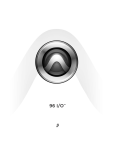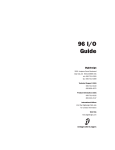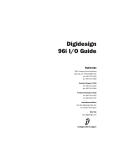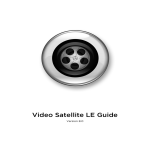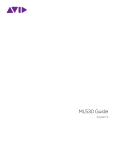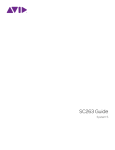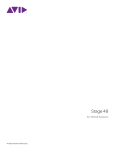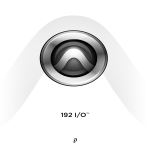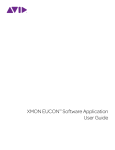Download Avid Technology HD I/O Specifications
Transcript
96 I/O™ Version 8.0 Legal Notices Radio and Television Interference This guide is copyrighted ©2008 by Digidesign, a division of Avid Technology, Inc. (hereafter “Digidesign”), with all rights reserved. Under copyright laws, this guide may not be duplicated in whole or in part without the written consent of Digidesign. This equipment has been tested and found to comply with the limits for a Class A digital device, pursuant to Part 15 of the FCC Rules. 003, 96 I/O, 96i I/O, 192 Digital I/O, 192 I/O, 888|24 I/O, 882|20 I/O, 1622 I/O, 24-Bit ADAT Bridge I/O, AudioSuite, Avid, Avid DNA, Avid Mojo, Avid Unity, Avid Unity ISIS, Avid Xpress, AVoption, Axiom, Beat Detective, Bomb Factory, Bruno, C|24, Command|8, Control|24, D-Command, D-Control, D-Fi, D-fx, D-Show, D-Verb, DAE, Digi 002, DigiBase, DigiDelivery, Digidesign, Digidesign Audio Engine, Digidesign Intelligent Noise Reduction, Digidesign TDM Bus, DigiDrive, DigiRack, DigiTest, DigiTranslator, DINR, D-Show, DV Toolkit, EditPack, Eleven, HD Core, HD Process, Hybrid, Impact, Interplay, LoFi, M-Audio, MachineControl, Maxim, Mbox, MediaComposer, MIDI I/O, MIX, MultiShell, Nitris, OMF, OMF Interchange, PRE, ProControl, Pro Tools M-Powered, Pro Tools, Pro Tools|HD, Pro Tools LE, QuickPunch, Recti-Fi, Reel Tape, Reso, Reverb One, ReVibe, RTAS, Sibelius, Smack!, SoundReplacer, Sound Designer II, Strike, Structure, SYNC HD, SYNC I/O, Synchronic, TL Aggro, TL AutoPan, TL Drum Rehab, TL Everyphase, TL Fauxlder, TL In Tune, TL MasterMeter, TL Metro, TL Space, TL Utilities, Transfuser, Trillium Lane Labs, Vari-Fi Velvet, X-Form, and XMON are trademarks or registered trademarks of Digidesign and/or Avid Technology, Inc. Xpand! is Registered in the U.S. Patent and Trademark Office. All other trademarks are the property of their respective owners. Product features, specifications, system requirements, and availability are subject to change without notice. Guide Part Number 9106-59119-00 REV A 11/08 Documentation Feedback At Digidesign, we're always looking for ways to improve our documentation. If you have comments, corrections, or suggestions regarding our documentation, email us at [email protected]. Communications Statement This equipment has been tested to comply with the limits for a Class A digital device. Changes or modifications to this product not authorized by Digidesign, Inc., could void the Certification and negate your authority to operate the product. This product was tested for CISPR compliance under conditions that included the use of peripheral devices and shielded cables and connectors between system components. Digidesign recommends the use of shielded cables and connectors between system components to reduce the possibility of causing interference to radios, television sets, and other electronic devices. Safety Statement This equipment has been tested to comply with USA and Canadian safety certification in accordance with the specifications of UL Standards; UL1419 and Canadian CSA standard; CSA C22.2 No.1-M90. Digidesign Inc., has been authorized to apply the appropriate UL & CUL mark on its compliant equipment. Important Safety Instructions When using electric or electronic equipment, basic precautions should always be followed, including the following: • Read all instructions before using this equipment. • To avoid the risk of shock, keep this equipment away from rain water, and other moisture. Do not use this equipment if it is wet. • The equipment should only be connected to the correct rating power supply as indicated on the product. • Do not attempt to service the equipment. There are no user-serviceable parts inside. Please refer all servicing to authorized Digidesign personnel. • Any attempt to service the equipment will expose you to a risk of electric shock, and will void the manufacturer’s warranty. • The product should be connected only to the correct power supply as indicated on the product. Warning This product contains chemicals, including lead, known to the State of California to cause cancer and birth defects or other reproductive harm. Wash hands after handling. Communications & Safety Regulation Information Compliance Statement The model 96 I/O complies with the following standards regulating interference and EMC: • FCC Part 15 Class A • EN55103 – 1, environment E4 • EN55103 – 2, environment E4 • AS/NZS 3548 Class A Warning! • Pro Tools|HD audio interfaces need room at their sides to maintain proper air flow and cooling. • Do not install these units into a rack or other enclosure that doesn't leave room on either side for the unit fans. • Do not block the sides of the units (where fans are), or disconnect the fan. • If the units are racked up in a case, remove all lids, doors, or covers before operating the units. • Failure to do so can result in the units overheating very quickly, which can permanently damage them. contents Chapter 1. Introduction to the 96 I/O . . . . . . . . . . . . . . . . . . . . . . . . . . . . . . . . . . . . . . . . . 1 What’s Included . . . . . . . . . . . . . . . . . . . . . . . . . . . . . . . . . . . . . . . . . . . . . . . . . . . . . . . . . 1 System Requirements and Compatibility Information . . . . . . . . . . . . . . . . . . . . . . . . . . . . . . . 1 Digidesign Registration . . . . . . . . . . . . . . . . . . . . . . . . . . . . . . . . . . . . . . . . . . . . . . . . . . . . 2 About This Guide. . . . . . . . . . . . . . . . . . . . . . . . . . . . . . . . . . . . . . . . . . . . . . . . . . . . . . . . . 2 About www.digidesign.com . . . . . . . . . . . . . . . . . . . . . . . . . . . . . . . . . . . . . . . . . . . . . . . . . 3 Chapter 2. 96 I/O Hardware Overview . . . . . . . . . . . . . . . . . . . . . . . . . . . . . . . . . . . . . . . . . 5 96 I/O Front Panel . . . . . . . . . . . . . . . . . . . . . . . . . . . . . . . . . . . . . . . . . . . . . . . . . . . . . . . 5 96 I/O Back Panel . . . . . . . . . . . . . . . . . . . . . . . . . . . . . . . . . . . . . . . . . . . . . . . . . . . . . . . 7 Appendix A. Card Removal and Replacement . . . . . . . . . . . . . . . . . . . . . . . . . . . . . . . . . . 11 Removing an I/O Card . . . . . . . . . . . . . . . . . . . . . . . . . . . . . . . . . . . . . . . . . . . . . . . . . . . . 11 Replacing an I/O Card . . . . . . . . . . . . . . . . . . . . . . . . . . . . . . . . . . . . . . . . . . . . . . . . . . . . 13 Contents iii iv 96 I/O Guide chapter 1 Introduction to the 96 I/O The Digidesign® 96 I/O™ 16-channel digital audio interface features 24-bit analog-to-digital (A/D) and digital-to-analog (D/A) converters, and supports sample rates of up to 96 kHz. 96 I/O Features • 16 discrete channels of input and output, with 4-segment LED meters on each channel. Input and output features include: What’s Included • 96 I/O audio interface • AC power cable • DigiLink cable (18 inches [0.46m]) • BNC cable (18 inches [0.46m]) • 96 I/O Guide • Digidesign Registration Information Card • 8 channels of 24-bit, 96 kHz-capable analog input and output • 2 channels of 24-bit, 96 kHz-capable digital S/PDIF and AES/EBU I/O • 8 channels of Optical (ADAT) digital I/O • Loop Sync In and Out for synchronizing additional Pro Tools|HD® interfaces and peripherals • External Clock In and Out (1x Word clock or 256x SuperClock) for synchronizing with external devices • Expansion DigiLink port for connecting additional Pro Tools|HD audio interfaces • Legacy port for connecting qualified Pro Tools|24 MIX™ audio interfaces System Requirements and Compatibility Information The Digidesign 96 I/O requires a Digidesignqualified Pro Tools|HD system. The 96 I/O can be used as the only audio interface in a Pro Tools|HD system (no other audio interface present), or as an expansion I/O when combined with a 192 I/O™, 192 Digital I/O, 96i I/O™, or other 96 I/O audio interface. Digidesign can only assure compatibility and provide support for hardware and software it has tested and approved. For complete system requirements and a list of Digidesign-qualified computers, operating systems, hard drives, and third-party devices, refer to the latest information on the Digidesign website: www.digidesign.com/compatibility Chapter 1: Introduction to the 96 I/O 1 Digidesign Registration Review the enclosed Digidesign Registration Information Card and follow the instructions on it to quickly register your purchase online. Registering your purchase is the only way you can be eligible to receive complimentary technical support and future upgrade offers. This is one of the most important steps you can take as a new user. Conventions Used in This Guide Digidesign guides use the following conventions to indicate menu choices and key commands: : Convention Action File > Save Choose Save from the File menu Control+N Hold down the Control key and press the N key Control-click Hold down the Control key and click the mouse button Right-click Click with the right mouse button About This Guide This guide describes the 96 I/O features and connectors. For complete instructions on connecting and configuring your Pro Tools|HD system, see the HD Setup Guide. For additional information about using Pro Tools software, see the Pro Tools Reference Guide. The following symbols are used to highlight important information: User Tips are helpful hints for getting the most from your system. Important Notices include information that could affect your data or the performance of your system. Shortcuts show you useful keyboard or mouse shortcuts. Cross References point to related sections in this guide and other Digidesign guides. 2 96 I/O Guide About www.digidesign.com The Digidesign website (www.digidesign.com) is your best online source for information to help you get the most out of your Pro Tools system. The following are just a few of the services and features available. Product Registration Register your purchase online. See the enclosed Digidesign Registration Information Card for instructions. Support and Downloads Contact Digidesign Technical Support or Customer Service; download software updates and the latest online manuals; browse the Compatibility documents for system requirements; search the online Answerbase; or join the worldwide Pro Tools community on the Digidesign User Conference. Training and Education Study on your own using courses available online or find out how you can learn in a classroom setting at a certified Pro Tools training center. Products and Developers Learn about Digidesign products; download demo software or learn about our Development Partners and their plugins, applications, and hardware. News and Events Get the latest news from Digidesign or sign up for a Pro Tools demo. Pro Tools Accelerated Videos Watch the series of free tutorial videos. Accelerated Videos are designed to help you get up and running with Pro Tools and its plug-ins. To learn more about these and other resources available from Digidesign, visit the Digidesign website (www.digidesign.com). Chapter 1: Introduction to the 96 I/O 3 4 96 I/O Guide chapter 2 96 I/O Hardware Overview This chapter describes the front and back panel features of the 96 I/O. See the HD Setup Guide for complete system installation and configuration instructions. If you are adding the 96 I/O to an existing system, see the Expanded Systems Guide. 96 I/O Front Panel 96 I/O Front Panel Power Switch and LED Ring Sample Rate LEDs This button turns the 96 I/O on and off. These LEDs display the current sample rate of the 96 I/O internal crystal oscillator: 44.1 kHz, 48 kHz, 88.2 kHz, and 96 kHz. The LED ring around the power button lights green when the unit has powered up successfully and is connected to an active Pro Tools|HD system. If the LED ring is orange, the unit has power, but the computer it is connected to is shut down. Chapter 2: 96 I/O Hardware Overview 5 Loop Master LED Input and Output LEDs and Meters The LOOP MASTER LED indicates which Pro Tools|HD audio interface is the master Pro Tools peripheral. Loop Master defaults to the first Pro Tools|HD I/O connected to the core card. On Pro Tools|HD (for PCIe), this is the Accel Core card. On Pro Tools|HD (for PCI), this is the HD Core card. 16 sets of four-segment LEDs indicate signal level for each of the 96 I/O channels. The Loop Master LED is always lit when only a single interface is present, regardless of the synchronization mode. In expanded systems, only one Pro Tools|HD I/O can be Loop Master at a time. When you change the clock source to an external clock on a Pro Tools|HD I/O, it automatically becomes the Loop Master and all other Pro Tools|HD I/Os in the chain switch to Loop Slave mode. Sync Mode LEDs The SYNC MODE LEDs indicate the current Pro Tools Clock Source and Sync mode: INT (Internal) The 96 I/O standard clock setting, this mode illuminates when the 96 I/O sample clock is generated by its internal crystal oscillator, as determined by the session Sample Rate. DIG (Digital) Indicates that an external AES/EBU, Optical (ADAT), or S/PDIF device is providing master clock to Pro Tools. LOOP (Loop Sync) Indicates that the 96 I/O is slaving to another Pro Tools|HD I/O through Loop Sync. EXT (External) Indicates the 96 I/O External Clock In port is providing master clock to Pro Tools. For more information on Pro Tools clock options, see the HD Setup Guide. 6 96 I/O Guide These meter LEDs indicate –42 dB, –18 dB, –6 dB, and 0 dB (from bottom to top), referenced to Full Scale digital. Full Scale digital (0 dBFS) does not always indicate signal clipping levels. Use the onscreen meters in Pro Tools to determine whether a signal is clipping. For more information, see the HD Setup Guide. Two additional LEDs, located to the left of the meters, indicate whether the meters display input or output levels; the meters indicate output levels by default, and can be switched from the Hardware Setup dialog in Pro Tools. 96 I/O Back Panel 96 I/O back panel Analog Inputs Analog Outputs The 96 I/O has eight balanced, 1/4-inch TRS connectors for analog audio input connections. These inputs feature 24-bit A/D converters. The 96 I/O has eight balanced/unbalanced, 1/4-inch TRS connectors for analog audio output connections. These outputs feature 24-bit D/A converters. The TRS inputs are wired as follows: 96 I/O input wiring for balanced connections Tip Hot (or +) Ring Cold (or –) Sleeve Ground Input operating levels are switchable between +4 dBu and –10 dB(V) operation. (For instructions, see the HD Setup Guide.) These connectors also support unbalanced connections. Unbalanced connections are supported with the use of standard 1/4-inch mono phone plugs. All eight output channels are continuously active. Output operating levels are switchable between +4 dBu and –10 dBV operation. (For instructions, see the HD Setup Guide.) Unbalanced connections are supported with the use of standard 1/4-inch mono phone plugs. AES/EBU Digital In and Out These are balanced, three-conductor XLR connectors that accept and output a stereo, 24-bit AES/EBU digital data stream. These two ports support up to 96 kHz sample rates. Chapter 2: 96 I/O Hardware Overview 7 S/PDIF Digital In and Out About Lightpipe-Compatible Devices These are unbalanced RCA jacks that accept and output a stereo S/PDIF digital data stream. S/PDIF supports up to 24-bit audio, at sample rates up to 96 kHz. Lightpipe is an industry standard, eight-channel optical digital audio connection created by Alesis. Lightpipe is found on many devices, including Optical (ADAT) decks, modular digital multitracks (MDMs), sound cards, A/D or D/A converters, and digital consoles. To maintain data integrity and minimize jitter, use only 75-ohm coaxial cable for S/PDIF connections. Loop Sync In and Out Loop Sync is a dedicated clock signal for synchronizing multiple Pro Tools|HD peripherals together. Loop Sync uses a Word clock signal based on sample rates of either 44.1 kHz or 48 kHz. As sample rate increases in the system, Loop Sync continues to operate at a base rate of 44.1 kHz or 48 kHz, depending upon the higher rate. The Loop Sync In and Out ports are standard BNC connectors that output a 1x Word clock signal. Loop Sync should only be used to chain multiple Pro Tools|HD peripherals together (audio interfaces and the Digidesign SYNC HD™ or SYNC I/O™). For more information on Loop Sync and its connection requirements, see the HD Setup Guide. Optical (ADAT) In and Out The Optical ports accept up to eight channels of Optical (ADAT) input and output, or two channels (stereo) optical S/PDIF input and output. Optical (ADAT) mode supports sample rates up to 48 kHz. In TOS-Link mode, the 96 I/O supports two-channel Optical input and output at sample rates up to 96 kHz. 8 96 I/O Guide EXT. CLOCK In and Out The External Clock In and Out ports are standard BNC connectors that receive and output a Word clock signal. These ports can be used to synchronize the 96 I/O to any device that requires (or provides) word clock. External Clock In and Out are configured in the Hardware Setup dialog. Because the Loop Sync and Word Clock ports pass crucial timing information, use highquality 75-ohm coaxial cables. Primary Port The Primary Port is used to connect the 96 I/O to your Pro Tools|HD cards, or to another Pro Tools|HD audio interface, using a DigiLink cable. • When the 96 I/O is the only audio interface in the system, the Primary Port is connected directly to the Accel Core card (Pro Tools|HD for PCIe systems) or HD Core card (Pro Tools|HD for PCI systems). • When the 96 I/O is used as an additional I/O in an expanded Pro Tools|HD system, the 96 I/O Primary Port can be connected to an HD Accel or HD Process card, or to the Expansion port on a 192 I/O, 192 Digital I/O, or 96 I/O. For information about connecting expanded Pro Tools|HD systems, see the Expanded Systems Guide. Expansion Port AC Power The Expansion Port is used to connect an additional Pro Tools|HD I/O to the 96 I/O. This port is only available when the 96 I/O is connected to a Pro Tools|HD card (it is not available when the 96 I/O is connected to the Expansion Port on another audio interface). This connector accepts a standard AC power cable (one is included with each audio interface). The 96 I/O is auto power-selecting (100V to 240V) and will automatically work with a standard modular cable to connect to AC power receptacles in any country. Legacy Port The Legacy Port is used to connect qualified Pro Tools|24 MIX-series Digidesign audio interfaces to the 96 I/O. You can connect two eightchannel interfaces (such as the 888|24 I/O™ or 882|20 I/O™) or a single sixteen-channel interface (1622 I/O™ or 24-bit ADAT Bridge I/O™) for expanded input and output options, using their original cables. When the Legacy Port has been activated from within Pro Tools, your MIX-series I/O will appear as channels 17–32 in the Pro Tools mixer. For more information on using Expansion or Legacy audio interfaces, see the HD Setup Guide and the Expanded Systems Guide. Legacy and Expansion Peripheral Port Limitations Because both the Legacy Port and the Expansion Port use channels 17–32, you can only use one at a time. The Legacy port is not available in any session in which the sample rate is set higher than 48 kHz. Accessory Port This port is not supported. Chapter 2: 96 I/O Hardware Overview 9 10 96 I/O Guide appendix a Card Removal and Replacement Removing an I/O Card In the event of a problem with the A/D or D/A cards in your 96 I/O, you can remove the card and send it to Digidesign for repair. 3 Remove all of the 16 small phillips-head screws around the edges of the top cover. Keep the screws (you will need them to re-attach the top cover). The modular nature of the Pro Tools|HD system lets you return the specific card instead of the entire 96 I/O. Your Pro Tools|HD system will continue to function while missing a single card. It will not function if more than one of the factory-installed cards is removed. Before handling any of the cards or internal components of 96 I/O, discharge any static electricity by touching the outer casing of the power supply. To remove an I/O card from the 96 I/O: 1 Power off and disconnect the 96 I/O from your Pro Tools|HD system. Removing the top cover screws 4 Lift off the top of the 96 I/O and set it aside. 5 Gently disconnect the 50-pin connector from the edge of the card. . 2 Make sure that the 96 I/O AC cord remains plugged in so that it is grounded. Appendix A: Card Removal and Replacement 11 6 Remove the five screws on the front plate of the card to be removed. 8 Pull the card out by gripping the edges between your thumb and forefinger on each side. Pull straight back, lifting very slightly to avoid contact between components on the underside of the card and the 96 I/O back panel faceplate. 7 To discharge any static electricity, touch the power supply casing. It is a good idea to do this often, throughout the process. When you remove a card, pay particular attention to keeping components on the surfaces of the card from bumping into any of the internal components or the back panel on the 96 I/O. 9 Place the card immediately in an anti-static bag and send it to Digidesign according to instructions from Digidesign Customer Support. Hardware Setup Changes After Removing a Card Touching power supply casing to discharge any static electricity 12 96 I/O Guide The Hardware Setup dialog reflects the removal of an I/O card by settings corresponding inputs and outputs to None. The remaining inputs and outputs will function normally. Replacing an I/O Card To replace a card: 1 Power off and disconnect the 96 I/O from your Pro Tools|HD system. 2 Make sure that the 96 I/O AC cord remains plugged in so that it is grounded. 3 Remove all 16 of the small Phillips-head screws around the edges of the top cover. Put the screws in a safe place. 4 Lift off the top of the 96 I/O and set it aside. 5 If the card you are replacing is still connected to the 96 I/O, see “Removing an I/O Card” on page 11. 6 To discharge any static electricity, touch the power supply casing. It is a good idea to do this often, throughout the process. 7 Look into the empty bay to locate the guide rails for the card Placing the edge of the card into the guide rails 8 Slide the edges of the card into the guide rails on each side of the bay. Push the card all the way in until the card’s faceplate is nearly flush with the rear panel of the 96 I/O. 9 Screw the card’s faceplate onto the rear panel surface of the 96 I/O with the same screws you removed from the empty bay cover. 10 Locate the raised ridge in the middle of the 50-pin cable which connects to the 96 I/O chassis. This ridge is only on one side of the connector, and there is a matching groove on only one side of the 50-pin connector on the card. Example of an empty bay. Note guide rails along the inside edge Locating the ridge on the 50-pin cable and the matching groove on the 50-pin connectors on the card Appendix A: Card Removal and Replacement 13 11 Gently push the cable connector into the 19 Choose Setup > Hardware and confirm that card’s connector. The ridge on the cable connector must be line directly into the groove on the card connector. Be very careful not to bend any of the pins. the new card is recognized: • If you installed a 96 AD card, you should see a new tab called Analog In 1–8. • If you installed a 96 DA card, you should see a new tab called Analog Out 1–8. 20 If the new card does not appear in the Hard- ware Setup dialog, power down, check the seating of the card, and recheck the cables inside the 96 I/O. Hardware Setup Changes Whenever a card is removed or replaced, the Hardware Setup I/O routing reverts to original defaults. For more information, see the HD Setup Guide. Pressing the 50-pin cable connector into the card 12 Place the top cover onto the 96 I/O and re- place the screws that you removed with it. 13 Connect the 96 I/O to your Pro Tools|HD system. 14 Press the 96 I/O Power switch. 15 When you power on the unit, verify that the LED ring around the power switch lights orange. 16 Start up the computer. 17 When you start the computer, verify that the LED ring around the power switch turns from orange to green. (If this does not occur, see “Troubleshooting” on page 14.) 18 Launch Pro Tools. 14 96 I/O Guide Troubleshooting If the power ring does not turn from orange to green when you start the computer, make sure you reconnected the DigiLink cable to the Primary port on the back of the unit. If the DigiLink cable is securely fastened and the other end is plugged into a Pro Tools|HD card, you may have inadvertently disconnected another 50-pin cable when installing the card. www.digidesign.com DIGIDESIGN 2001 Junipero Serra Boulevard Daly City, CA 94014-3886 USA Tel: 650.731.6300 Fax: 650.731.6399 TECHNICAL SUPPORT (USA) Tel: 650.731.6100 Fax: 650.731.6375 PRODUCT INFORMATION (USA) Tel: 800.333.2137 INTERNATIONAL OFFICES Visit the Digidesign website for contact information



















